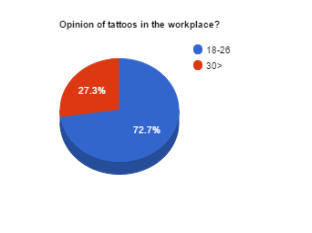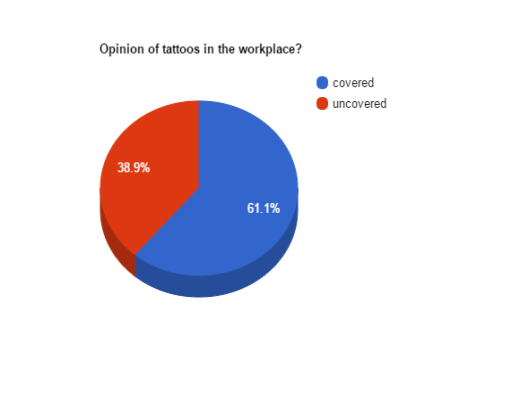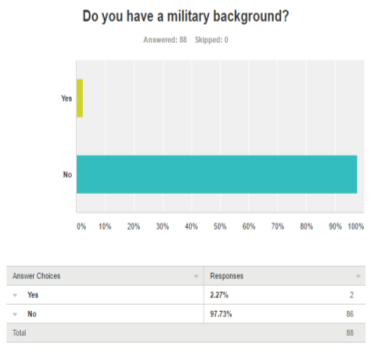Study Bay Coursework Assignment Writing Help
Anna Marks
Jo Vale
Abstract
This research looks at the stereotype of tattoos in the workplace today.
The research draws upon mostly primary sources including telephone interviews and questionnaires.
This report intends to demonstrate that social attitudes are changing in relation to tattoos and that by identifying that tattoos are a part of life now and will continue to be, the aim is to eliminate the assumption that all people with tattoos are involved with crime or unemployable.
The results were surprising as they revealed that the younger generations were more conservative in relation to tattoos in a professional environment.
Introduction
By describing and analysing its most important aspects, this report intends to discuss and evaluate the results that originated through research into the stigma of tattoos in the workplace on people today.
The issues covered by this report include; the percentage of people who feel discriminated against because of their tattoos and the people who don’t agree with tattoos being on display in the workplace.
This topic is important as now a fifth of all British adults have been tattooed (J Henley) and with that number, ever increasing tattoos are becoming the social norm, employers will have to start making some changes to their dress codes if they want a new generation of employees. Tattoos started as an exclusively female practice in ancient Egypt, mummies found with tattoos were usually dismissed and assumed they were of a “dubious status ” (C Lineberry) and until the early 1990’s this opinion was largely unchanged, with only 15% of baby boomers (born between 1946-1964) with tattoos and 59% having the opinion that if you had tattoos you were involved with crime or in enlisted military personnel. (J Squires)
However, social attitudes are changing and that is simply not the case any more, with increasingly more professionals reporting they have tattoos.
Methodology
A mixed method approach was used as good variation in data collection usually, leads to greater validity within the work. This was demonstrated with a wide variety of responses from several different sources.
The research was approached from a practical standpoint, qualitative and quantitative data was collected through interviews and questionnaires. Quantitate data provided much-needed clarification throughout the research process. However, this method of data collection limited participant responses and are, therefore of little use if depth is required.
The methodological approach involved qualitative methods within the research. This method is more suitably used when less information is known, this allows those who do not want to share too much to contribute, without losing out on important information. However, there was a small percentage of people who preferred not to divulge that private information.
Primary sources were used more broadly, as the research contained some questions which some might find sensitive in nature and it allowed the questions that needed to be asked, to be asked. This was initially deemed unsuitable for primary data collection, however, the anonymity of the primary data method essentially worked in favour of the research as participants were much more open with their answers when provided with secrecy.
Secondary sources were very valuable within research as it allowed statistic comparison and outside data to aid preliminary research. Comparisons of documents and records as well as the use of the census were helpful and reinforced the primary research done.
The use of secondary sources helped construct an argument that would have been difficult to make without this information. However, information gathered through this source did create reconsiderations on how to go about the research, for example, secondary data offered a new perspective which introduced new ideas and gave the research more range.
Results and Findings
The findings suggested that people, in general, did not feel as victimised over their tattoos in the workplace as initially thought, it can be seen from the evidence that out of 88 tattooed individuals aged 18-61 only 5 people felt that they had been treated differently at work or not gained employment because of their tattoos, the small 5.7% of people thought that “They will affect me in the future”. A much higher percentage of people did not feel discriminated against for their tattoos as those who did. This was an unexpected finding.
The findings showed 94.3% of people who were asked did not feel that their employers had any issues with their tattoos at all.

The results showed expectedly that some of the over 30’s disliked visible tattoos in the workplace and thought that they should be covered, with most describing them as “unprofessional” and “inappropriate”
61% of people who took the survey without tattoos felt they should be covered up. Of that 61%, only 27% of them were over 30 making the majority between 18-26-year-olds who were against visible tattoos in a professional environment


Discussion
 Out of the vast majority of participants with tattoos, 97% did not have any involvement with the navy/army or with crime. It was initially thought that these percentages would be higher as the stigma of tattooed people being involved in crime and/or enlisted is a popular reason in which most people do not appear to like them, with 1 participant saying “Tattoos only used to be for thugs.”
Out of the vast majority of participants with tattoos, 97% did not have any involvement with the navy/army or with crime. It was initially thought that these percentages would be higher as the stigma of tattooed people being involved in crime and/or enlisted is a popular reason in which most people do not appear to like them, with 1 participant saying “Tattoos only used to be for thugs.”

The original hypothesis does not fit with the results maintained through the research, it was initially thought that there would be a significant difference between a younger person’s positive attitude to visible tattoos in the work-place than an older person’s negative attitude. This was an unexpected finding, however, to try and explain this Wallop (2015) discussed the impact of the so-called ‘midlife crisis’s’ affecting those over 30 and how it is becoming increasingly common for them to get tattoos later in life “Tattoos, are now as much a part of a midlife crisis as scouring Facebook for old flames. A recent survey found that almost a quarter of 30 to 59-year-olds have a tattoo somewhere on their body, compared with less than one in six of those aged between 18 and 24”. This shows the stigma of tattoos falling away slowly and the older generation gradually backing down on the hardened stereotyped view of tattoos. Backing this theory up, an article from Forbes, published in 2011 argues that tattoos still have a negative impact on employment (L Faw) However, in 2013 they retracted their statement, saying tattoos were “no longer a kiss of death in the workplace” (R Hennessey) This correlates with the data collected through previous research that was conducted and is interesting because, with just 2 years difference it can be seen from the evidence that social attitudes appeared to have changed, these results present an interesting finding as it seems that it is millennials that have become more conservative in their views.
However, a study by CareerBuilder showed that 31% of employers said that having a visible tattoo is one of the reasons they would be less likely to promote an individual (2011)
86% of young professionals do not think tattoos reduce the chance of getting jobs (A Mishra & S Mishra) and that “grooming and business attire were more important indicators in the hiring decision than tattoos and piercings (J McLeod) as well as feeling that they feel more approachable by younger generations in the workplace.
Conclusion
The thesis of this report was to analyse and discuss conducted research into the stigma of tattoos in the workplace.
In conclusion, from the evidence presented in this report, it can be seen that the hypothesis does not connect with the results presented. Initially, it was thought that younger people would be more open to displaying tattoos at work, in fact, this was not the case. 72.2% of 18-26-year-olds do not think tattoos showing in the workplace is appropriate, it was the older generation that had fewer problems with tattoos. However, with no information from the age range spanning between 27-29 statistics, it would be irresponsible to presume the figures that they fit into.
Tattoos have been here for a long time and the findings suggest that they will be around for a lot more. It seems that tattoos may become more acceptable not only in the workplace but in general society
References
The rise and rise of the tattoo, J Henley, Tuesday 20 July 2010 https://www.theguardian.com/artanddesign/2010/jul/20/tattoos
Visible Tattoos And Other Corporate No-Nos, Larissa Faw, October 25 2011, https://monkessays.com/write-my-essay/forbes.com/sites/forbeswomanfiles/2011/10/25/visible-tattoos-and-other-corporate-no-nos/#363efdd3670f
Tattoos No Longer A Kiss Of Death In The Workplace, Rachel Hennessey, February 27, 2013 https://monkessays.com/write-my-essay/forbes.com/sites/rachelhennessey/2013/02/27/having-a-tattoo-and-a-job/#120e998d5b92
Anurag Mishra & Sasmita Mishra p.3, April, 2015 https://monkessays.com/write-my-essay/ijird.com/index.php/ijird/article/view/69975/54946
The Hidden Mark: An Ethnographic Examination of Visibility in Heavily Tattooed Professionals, Josh M. McLeod p.23 https://dspace.royalroads.ca/bitstream/handle/10170/703/mcleod_josh.pdf?sequence=1&isAllowed=y
Harris Interactive on behalf of CareerBuilder June 29, 2011,
Bad Breath, Heavy Cologne and Wrinkled Clothes Among Factors That Can Make You Less Likely to Get Promoted, https://monkessays.com/write-my-essay/careerbuilder.com/share/aboutus/pressreleasesdetail.aspx?sd=6%2F30%2F2011&id=pr642&ed=12%2F31%2F2011
Bibliography
The National Archives https://monkessays.com/write-my-essay/nationalarchives.gov.uk/
The Huffington Post https://monkessays.com/write-my-essay/huffingtonpost.com/annie-singer/tattoos-in-the-workplace-_b_9321408.html
